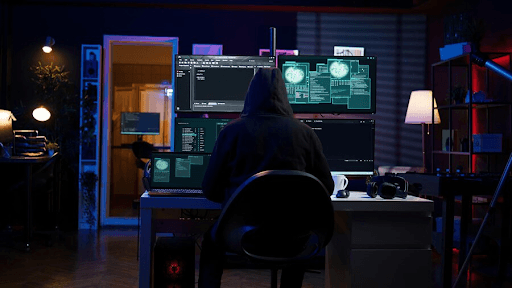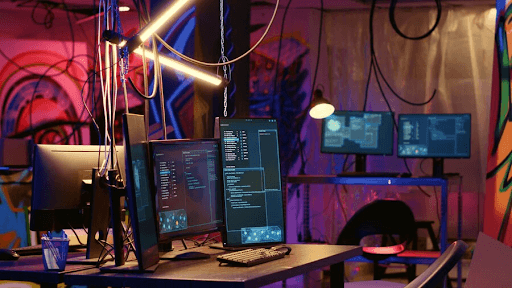The practice of hacking into computer systems or networks for political or social expression has become an ever-growing source of impact in the world of modern cybersecurity. As hacktivist groups’ cyberattacks become more complex and grandiose, security experts need to have a better understanding of the reasons and methods these operations are executed. Defenders are better able to enact more effective countermeasures on public, private, and government digital infrastructure. This article will describe key aspects of the hacktivist operation from a cybersecurity perspective.
Background on the Emergence of Hacktivism
Hacktivism as a concept emerged in the 1990s alongside public access to the internet and programming skills required to exploit networks and websites. Early hacktivist actions centered around making political statements by digitally defacing sites through message alteration or denial-of-service attacks. Additionally, some hacktivists publicized stolen data and documents that were provocative or damaging to the reputation of their targets.
As IT security trends evolved, large-scale cyberattacks transitioned from theoretical to commonplace in the 2000s and 2010s, pushing hacktivism beyond disrupting individual sites to complex technological sabotage. Anonymous and other hacktivist collectives could coordinate distributed denial-of-service (DDoS) campaigns across thousands of hijacked machines to overwhelm and shut down websites or online services. Hacking tools and tutorials also became more user-friendly and accessible during this period.
Defining Goals and Ethics Behind Hacktivism
Hacktivists refer to their actions as an alternative, impactful form of nonviolent protest that needs to be carried out to fight for transparency, remove censorship, or simply kill institutions and leaders who they characterize as corrupt, unethical, or oppressive. But there are different definitions of “ethical” hacking, from exposing secret or sensitive materials for the public good to online vandalism to humiliate targets rather than expose misconduct.
As with many hacktivist collectives, prominent hacktivist collectives are also decentralized and anonymous which contributes to finding it difficult to gauge the legitimacy of stated motives behind specific cyber campaigns. Participants across the operations often act because of individual politics rather than united group principles in the absence of defined leadership and organizational hierarchies.
Hacktivists tend to see their actions as civil as civil disobedience with free speech and the right to know the principle. But opponents argue that hacktivist attacks are too often damaging and that the privacy rights they violate are too often frequent and with no accountability standards, the arguments for hacktivist actions being always in the greater public interest are undermined.
Anonymous and "Hacktivist 1.0" Groups

Anonymous
Anonymous, the hacking collective, started from the early 2000s 4chan message boards and grew into a major political cyber campaign and hacktivist culture force. Being decentralized and international, Anonymous branches that work on such causes as free speech, anti-corruption, and human rights give participants the flexibility to target and tactics. Unfortunately, this structure also makes it difficult to control quality when data leaks or vetting membership.
Anonymous operations have disrupted and defaced websites ranging from national governments and corporations like Sony to groups like the KKK and ISIS. The collective is best known in the cybersecurity field for high-volume DDoS attacks and prominent data breaches against HBGary Federal, Stratfor, PayPal, and various government entities that publicized confidential information. Law enforcement has prosecuted dozens of suspected Anonymous participants, although identifying members remains challenging.
LulzSec
Starting in May and continuing long into June 2011, but disbanded, the hacktivist group Lulz Security, or LulzSec as they have been often shortened to, committed multiple large cyberattacks. It has described itself as a loosely knit team with no financial or ideological axes to grind that indulges in attacks due to a need to expose security vulnerabilities and for the chaos, for the lulz. Website defacement, exposing user account data, and DDoS campaigns aimed at taking down high-profile targets Sony, Nintendo, the CIA, and the FBI were some of their tactics.
Most notoriously, LulzSec breached Sony Pictures servers in 2011 and dumped sensitive company data publicly while mocking weak security measures. Law enforcement arrested affiliates like Hector Xavier Monsegur (alias “Sabu”), who then cooperated with authorities as an FBI informant against other group members. Many regard LulzSec as spurring increased cybersecurity focus on possible “insider threats” from within organizations.
The emergence of “Hacktivist 2.0” and Nation-State Ties
By the mid-2010s, traditional hacktivist groups adopted more sophisticated techniques while also facing greater opposition from law enforcement and private sector defense teams. This drove many hacktivists “underground” into more covert, specialized cells that collaborated with outside state or criminal actors when strategically advantageous.
Whereas Anonymous and LulzSec were focused on mass publicity around hacking and data leaks, this modern ‘Hacktivist 2.0’ paradigm is about impact and discretion over media profiles. The attacks employ infrastructure including botnets, command and control servers, and all too often zero-day exploits that demand more technological knowledge, as well as spending more development resources. Experts say that political hacktivists have been extensively collaborating with Chinese, Russian, North Korean, or Iranian state-sponsored groups, either by direct coordination or by purchasing capabilities.
The fact that this growing nexus of hacktivists and nation-states engaged in cyber warfare has provided more access to very advanced capabilities to disrupt critical infrastructure or conduct espionage. But partnerships can also get hijacked by hacktivist principles, so the pure PR value of partnering prompts regimes chiefly interested in geopolitical influence rather than piecemeal accountability or transparency to also attempt partnerships. The dynamics and ethics involved are complicated for each participant as follows.
State Actors. To provide technical guidance, resources and direction to hacktivists to undertake disruptive attacks against common opponents. They can, however, also use operations to inject disinformation or promote authoritarian interests abroad.
Hacktivists. Collaborate to gain powerful capabilities for minimal manpower while relying on state sponsors with problematic human rights records. Working together legitimizes those intolerable regimes and enables cyberattacks beyond what the individuals hope.
Such nuances in the assessment of hybrid relationships between activist hackers and state intelligence services can be shown with examples like the Syrian Electronic Army. Direct evidence that the group was working with Russian state sponsors is lacking. But when it comes to SEA cyber campaigns which overwhelmingly align and aid Kremlin interests, the more transparent argument of independent hacktivism rings increasingly questionable.
Anonymous Resurgence and Operations
The Anonymous collective's lower public profile after 2015 belied ongoing operations coordinated through IRC chats and secure messaging platforms. The group saw a noticeable resurgence in visibility and activity surrounding the 2020 George Floyd protests in the United States and 2021 civil rights demonstrations globally.
Participants attacked city police departments and government websites with DDoS attacks and hijacked live streams and radio frequencies to relay activist messages. It was a throwback to earlier hacktivist techniques by Anonymous in which digital mediums were being used as protest spaces, rather than primarily data theft. The use of digital fingerprints left behind and chat records allowed law enforcement to arrest and charge several suspected participants, but it has proven hard to fully identify the individual hackers who were involved.
Anonymous is considered one of the main examples of early 'Hacktivist 1.0' tactics and structure, which still has significant media savvy and disruptive capabilities even in the face of law enforcement targeting and countermeasures from cybersecurity teams. Yet modern operations are more selective and restrained than in the past high-volume campaigns that flooded sites and services indiscriminately. It almost certainly means that core internet infrastructure is more secure and that Anonymous has shifted to more symbolic attacks with less concern for the damage they can cause.

Notable Cyber Campaigns and Data Leaks
Hacktivist operations have also targeted government agencies, religious groups, and global event organizations beyond repeatedly compromised targets such as Sony, Stratfor, and HBGary Federal.
Vatican Leaks (2012-Present). Since 2012, the Vatican has suffered multiple waves of leaks of confidential documents revealing financial scandals and infighting within Catholic Church leadership. Not overt hacktivism, the insider digital leaks appear to attempt to reform perceived internal corruption, like with WikiLeaks’ financial industry releases.
WADA Medical Records Leak (2016). The “Fancy Bears” hacktivist group broke into the World Anti-Doping Agency database and leaked medical records of Simone Biles, Venus Serena Williams, and other star athletes in response to doping scandal allegations during the Rio Olympics. The sensitive personal health data not related to competitive performance claims were compromised in the incident.
2022 Qatar World Cup Hack (2022). Qatar was suspected of targeting public figures in a hacking operation. The list of the hackers' victims published by The Sunday Times and the TBIJ is long. It included the French ex-president of the Union of European Football Associations (UEFA), Michel Platini; the Swiss President Ignazio Cassis; the former British Chancellor of the Exchequer Philip Hammond; and others. It was for allegedly exposing corruption and worker exploitation related to the 2022 Qatar World Cup preparations.
Critics of many of the above cases point out that in all the cases, hacktivists frame data leaks as being in the service of accountability, transparency, or public safety, even when the breaches involve the release of private information about individuals not connected to any alleged misconduct. It is still a complicated ethical situation to navigate through hacktivist communities.
Evolution of Countermeasures Against Hacktivism
However, cyber security experts say the risk of the disruptive sort of hacktivist attack continues on public as well as private sector digital infrastructure. However, in the past decade countermeasures have evolved to minimize both technological and public relations damages.
Standardized incident response plans are adopted to assist organizations in coordinating their internal teams and law enforcement partners more appropriately in their response to attacks instead of reacting ad hoc.
DDoS protection services offer particular support and capacity for deflecting large traffic attacks that could otherwise flood sites and servers. They are capable of detecting and providing filtering to malicious traffic without the need for an organization to manage countermeasures.
Threat intelligence sharing partnerships between public and private sectors enable rapid ideas on hacktivist campaign developments and attacker tactics, techniques, and procedures.
Hacktivist attacks or data leaks have become a key focus for public relations strategy before, during, and after hacktivist attacks or data leaks.
However, experts add that no single organization can entirely prevent all data breaches or hacktivist attacks with only enough adversary capabilities and persistence. It is the time of the modern age when we don't live with the idea that we can just prevent everything and instead focus on risk management and good planning around resilience and response. This helps train staff to securely handle sensitive data and to prevent the network access of the attackers who inevitably find a way past the outer digital perimeters.
Debates around ethics and legality often focus on hacktivist intentions and means rather than disputed ends related to institutional transparency or accountability. However, the act of illegally accessing systems alone constitutes criminal computer intrusion under laws like the U.S. Computer Fraud and Abuse Act (CFAA) regardless of the motivations behind it. This legal landscape shifts the debate more toward proportionality in sentencing and charges for hacktivists versus harsher punishments reserved for foreign spies or cybercriminals focused on espionage or personal financial gain.
The Future Trajectory of Hacktivism
As shown by its powers to attract public attention and frustrate opponents, experts assess that hacktivism as a concept is not going anywhere. Besides connectivity, connectivity of smart devices, and critical infrastructure, technological advancement will only grow the possibilities of virtual protests. Yet, most of the analysis indicates that hacking for political and social dissent will continue to become more decentralized from the more organized collectives such as Anonymous to smaller cells and individuals. And collaboration with state-sponsored groups will make their techniques more advanced and covert.
Criminal charges and lawsuits against known hacktivist participants may gradually discourage novices from joining public collectives aside from low-level DDoS campaigns or website defacement. Operations will shift away from making public examples out of breached organizations towards clandestine compromise of data and systems for maximum disruption. Targets can encompass anything from government agencies to corporations, infrastructure like utilities or hospitals, places of worship, or academic networks.
As with the hacktivist context, the line between online political activism, nonviolent civil disobedience, and cybercrime is unclear in many ways, and different groups’ principles are stretched. The more that capabilities for both compromise and countermeasures grow, the more likely concepts such as digital sit-ins are being debated on an ethical level with real consequences. Experts say motivations and means for hacktivist attacks should be balanced, rather than reactionary, based on the damage done or the political persuasion of the perpetrator.


